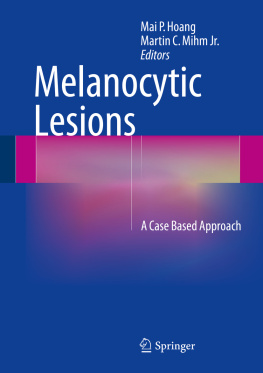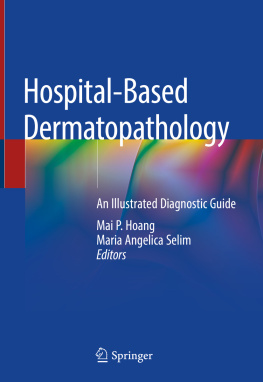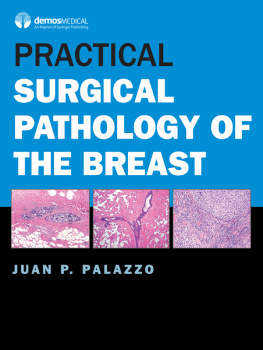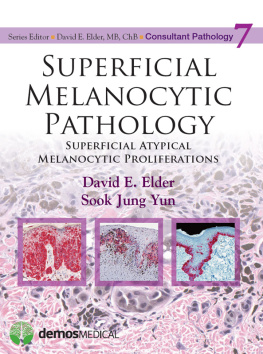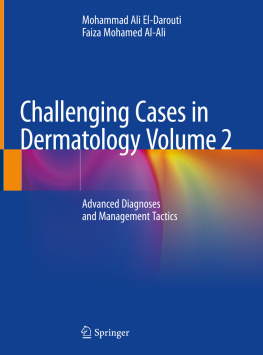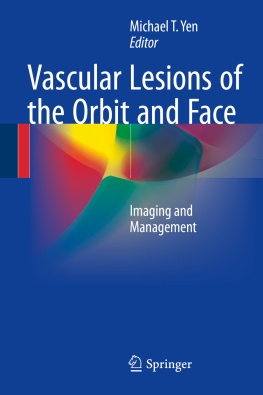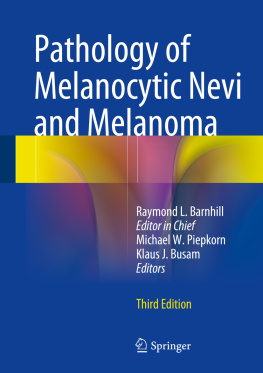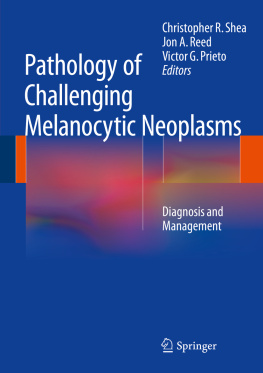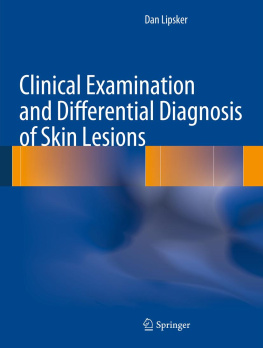Springer Science+Business Media New York 2014
Mai P. Hoang and Martin C. Mihm Jr. (eds.) Melanocytic Lesions 10.1007/978-1-4939-0891-2_1
1. Lentigo, Other Melanosis, and the Acquired Nevus
Benign pigmented lesions can occur at anytime in life, but they are more common in childhood and adolescence than later in life. It is estimated that 1 % of all infants have some types of pigmented lesion. The most common form of pigmented lesion in infancy is a lentigo. This lesion derives its name from its oval shape which resembles a lentil. Clinically it appears as a uniformly tan to brown, 45 mm, and well-demarcated lesion. Histologically, it has very distinctive features including elongated rete ridges in which there are an increased number of melanocytes present along the basal layer. Sometimes a small nest or two may appear at the tip of the rete ridges. The rete ridges are encased in pink collagen. There are often melanophages present in the dermis reflecting the increased melanin production by the melanocytes. Lentigines can occur anywhere on the skin, even the mucosal sites. The lentigo is important because the adjective lentiginous used to describe the hyperplasia along the basal layer is used in benign as well as malignant lesions that will be discussed in subsequent chapters. As indicated, lentigines can be either acquired or congenital. There is a congenital type that varies in size and covers large area of the body namely, nevus spilus. This lesion has the appearance of lentigo histologically but frequently has small nests containing two to three melanocytes. There are other types of melanocytic lesions that have been designated a given name because of their resemblance to lentigo clinically and histologically. There are other large pigmented lesions that have little or no significant melanocytic hyperplasia but are named by their clinical appearance or their location. One of the most common of these lesions is the solar lentigo. It is usually a macule or slightly raised lesion with variable size, few millimeters to several centimeters in size. The color may be uniformly tan or brown or even speckled. These lesions may be referred as liver spots on the sun-damaged skin but also show histologic changes of actinic keratosis or seborrheic keratosis. The histology shows a lesion with irregular epidermal hyperplasia with irregularly shaped and hyperplastic rete ridges. Some of these lesions will be associated with an actinic keratosis and almost all are associated with dermal solar elastosis. Another distinctive lesion is an ink-spot lentigo. This lesion occurs in markedly sun-damaged skin. It usually has an irregular color and reticulated pattern. It is characterized by extensive hyperpigmentation of the elongated rete ridges. The clinical picture of a highly reticulated black lesion combined with a histologic picture of prominently elongated and hyperpigmented rete ridges allows for easy diagnosis of this lesion. Another type of lesion associated with increased melanin pigment in basal keratinocytes and some slight increase in melanocytes is the caf au lait macule. Furthermore the so-called lower labial macule or mucosal melanotic macule exhibits marked melanosis with only slight melanocytic hyperplasia. It has a very distinctive clinical presentation of very rapid presentation on the lower lip and may vary in coloration from brown to black. It usually measures about 45 mm in width. It can have a slightly fuzzy border. This lesion is very stable and does not progress. Histologically, it is a hypermelanosis with minimal junctional melanocytic hyperplasia. If the lesion continues to grow, one must suspect lentigo maligna, and a biopsy is indicated. Finally, the vulva melanosis is a very important lesion that varies from few millimeters to covering the entire labia minora. These lesions are consisted of increased melanin pigment within basal keratinocytes without an increased number of junctional melanocytes.
Nevi can also occur at birth or can be congenital. Acquired nevi can occur any time after birth and usually are scattered and few in number but favor the head and neck region and the trunk above the beltline. Most lesions begin as flat or slightly raised pigmentations that vary in color from tan to dark brown. The early presentation of the nevus is a junctional nevus that is oval to round that measures no more than 5 mm in greatest dimension. Over time the lesions become raised and have a characteristic pigmentation, dark in the center and lighter at the periphery. This is characteristic of the compound nevi. Dermal nevi that are present especially in the head and neck regions are dome-shaped and usually dark brown to blue black and often become paler as the patient ages. Most compound nevi will become dermal nevi that vary in color from flesh to brown to dark brown and rarely to blue black. This evolution describes the common nevi that must be distinguished from Spitz and blue nevi which will be discussed separately. Patients who have the dysplastic nevi, which will be covered in depth in Chap. , have nevi scattered throughout their body. Dysplastic nevi will favor sites that are covered in contrast to common nevi that rarely appear on the scalp, buttock areas, and the breasts of women. With regard to the acquired benign lesions, symmetry is characteristic, while many nevi show an intraepidermal nested proliferation. There is an associated dermal component that is usually equal in distance to the intraepidermal component. If there is lateral extension of the intraepidermal component, it extends symmetrically, so there is no eccentric extension of the intraepidermal component beyond the dermal component.
Normal melanocytes are pigment-synthesizing cells that possess prominent dendritic processes and are confined to the epidermis. One epidermal melanocyte provides melanin for approximately 520 keratinocytes. They do not divide and rarely populate the skin after removal. On the contrary, the melanocytes within the nevus are not dendritic in morphology and have the capacity of dividing (Robinson et al. ).
The process of evolution of acquired nevi includes an intraepidermal proliferation of cells that form nests, cohesion of cells, and a free space around the nests. Melanin granules are usually coarse. Careful examination reveals small stubby processes that either abut the adjacent keratinocytes or attach to other melanocytes. The accepted theory of growth of nevi includes the passage of the so-called type-A cells into the dermis in which they usually lose pigmentation and form small nests containing round to oval cells. Type-A cells are found within the epidermis and superficial dermis. They have small nuclei and a tiny nucleolus and can show cytoplasmic pseudo-nuclear vacuole. Sometimes these cells are pigmented in the superficial portion of the dermis but lose completely the pigment as the lesion extends downward. Finally the cells become oval and fusiform. The round-oval and nonpigmented cells with scant eosinophilic cytoplasm are called type-B cells. They resemble the small lymphocytes or mast cells. The fusiform cells are called type-C cells (Lund and Stobbe ). The common acquired nevi are a phenomenon of the epidermis and papillary dermis. As the lesion expands it does not enter the reticular dermis but present as a raised papule. These lesions are totally different from Spitz, blue, and congenital nevi that predominantly involve the reticular dermis.

